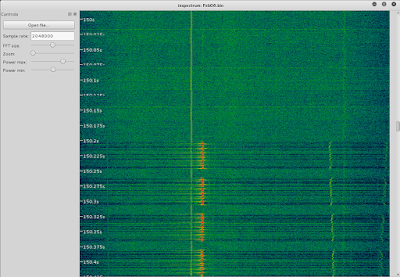I got a little help on Reddit. Thanks to PE1NUT for identify a way to visualize the crystal drift in the data and jddes for doing some sleuthing: he identified some On Off Keying (OOK) right at ignition. Sure enough; I loadded the data up in Inspectrum (which I should have done in the first place!):
Turns out Paul is using a 900 MHz wireless transmitter to ignite the rocket which sends OOK for about 1.5 seconds, which leave its mark at 1.5 GHz! There are peaks at ~ -300kHz and ~ +650kHz.
So I played around with filtering the data with mixed success initially. When you look at the data, the intermediate frequency (IF) is 110 Hz, or damn near zero, so half the spectrum is negative in frequency and the other half is positive. In order to filter just one half of the spectrum you need to have complex taps on your FIR filter. Now, the problem is most of the GNURadio filter blocks don't expose complex taps! The generic FIR filter and the band pass filter do but you have to provide the taps. Fair enough... but the gui to firdes (Finite Impulse Response Design tool) doesn't expose complex taps either! Ideally we'd want two band reject or notch filter. But since the band pass filter does work with complex taps we can add (n+1) band pass filters together to do the same thing - we just band pass two chunks instead of band rejecting one. Ultimately the flowgraph looks like this:
I also put in an automatic gain control block to try and deal with the jumps in the spectrum (horizontal lines). You can download the flowgraph if you like.
The easiest way to just filter a chunk of time is to split up the data file into three - the first part, the noisy part, and the last part. A combination of "split -b" and "head -c" are used on the command line, then the files are re-merged with CAT.
Here's the cleaned-up spectrum. There's still some jumps in the spectrum but the peaks are nulled out. We lose data, but the hope is that the data lost is outweighed by the interference removed.
I still don't get a valid fix during engine firing but I do reacquire satellites a bit quicker... meaning more data in flight! Updated trendline in black. Tracking from ~ 3500m to 5000m, covering 12 seconds of flight. There are 30 seconds from ignition to apogee, gnss-sdr loses lock during motor firing (~6 seconds) assuming that is insurmountable there is a maximum of 18 seconds of valid GPS data. Assuming perfection, you could start tracking on the next subframe and have a maximum of 20 seconds of flight data, (if you miss that subframe, 15 seconds) so we're over halfway there. Of course, not losing it during the motor firing would be ideal!
Money shot




No comments:
Post a Comment